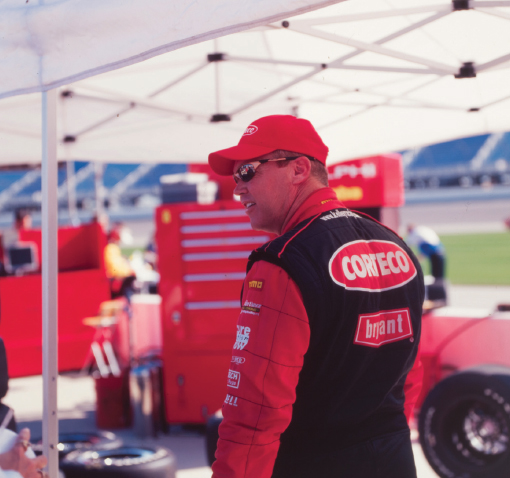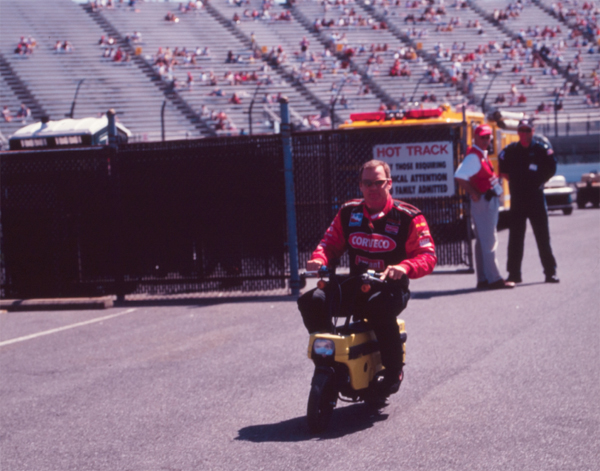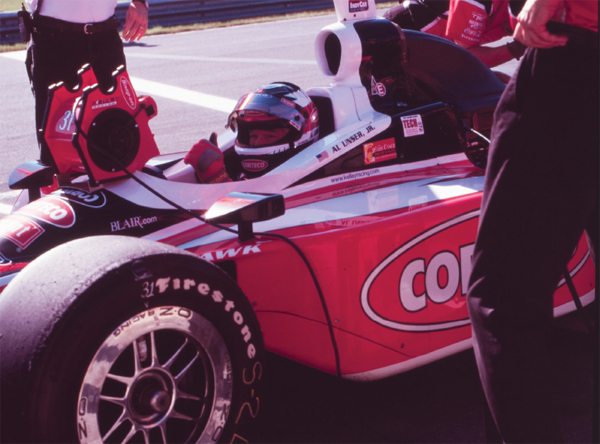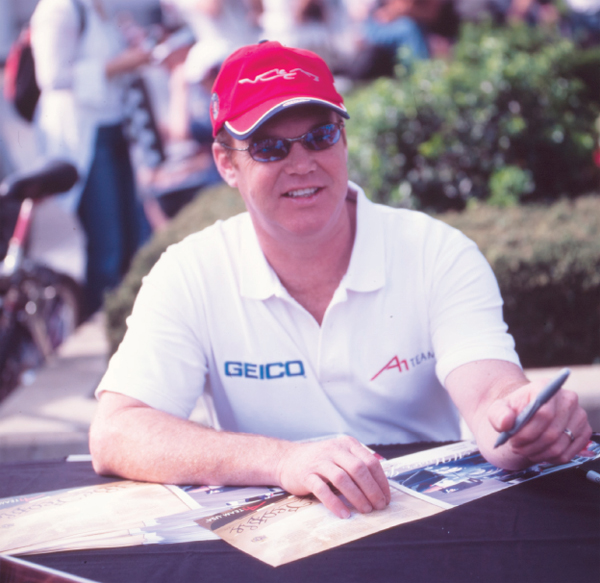
22
AL UNSER JR.

Won Indy 1992, 1994
Date of interview: January 2004
GOSH, THE way I was raised was “wanting to be like my father”: I think that’s every son’s feeling. My dad started me go-kart racing at nine years old. From that time forward he really just taught me the value of life. He taught me the instruments of racing to teach me about life—good sportsmanship, you have to work hard every day to advance yourself, to be a better person. You have to work at it every day of your life, and as soon as you don’t, someone will come along and do it better than you. He used racing to teach me all those things. It truly is something you have to work at every single day. You have to think about it every day in order to become a winner and a champion and all those things. It’s a wonderful business. Also, you know the saying “what goes around comes around”? If you do someone wrong on the racetrack he may not have an opportunity to get you back, but believe me, he will get you back. So you have to treat your fellow competitors fairly and honestly.
ON BEING A SORT OF TEST PILOT:
It’s a privilege to get to do something that most people rarely get to do. We used to “test” quite a lot and that was when the rules were not as strict as they are now. Both of my Indy wins were in cars where I was the “test pilot.” I had teammates with both of my wins, but I was what you might call the lead test pilot. The first car I won with had a chassis called the Galmer. The only other person that had that car was my teammate Danny Sullivan. We were lucky to win the race that day because Danny had a really bad day. My car ran really, really well. When we first built the car—on its very first run—I was the one to drive it. As I say, it was an honor and privilege to be the first one to drive. That story was more about the car: that is to say the chassis, because the Chevy engine was a known component. With the Galmer, it was more “the car” than anything else—the gearbox, the rear suspension, the tub, the aerodynamics, the front suspension. Everything was an unknown, and it had never been driven before. I love developing cars. That was my tenth year running at Indy. I had just turned thirty when I won my first 500.

I had developed cars before that. At my very first rookie season in 1983 I was in the Eagle—the 1983 Dan Gurney Eagle. It was developed in combination with Rick Galles, who was my car owner, and Dan Gurney, who I’d say was the “owner of the engineering.” He was a pioneer. He’s been “banging on metal” his entire life.

If it has wheels, Al Jr. will drive it.
I’m really proud of the years I spent with Roger Penske. The engineering and the dedication that he and his entire team put forth to win all the Indy 500s, the national championships—Roger is truly amazing. My very first year with Roger was the year I won Indy for the second time. Roger started as a driver but moved into being an owner very quickly. He developed and drove the early Corvettes at the Sebring Twelve-Hour Endurance run in the early 1960s. I liked the way that he ran the team and the way the team operated. I told you that the first year we won Indy it was the car that we developed. The second year I won Indy it was the engine that I developed . . . or I was the test pilot for. I drove it for the first time. It was a push rod engine. It was experimental and quite frankly developed in a record amount of time. I think in a span of about three or four months this engine went from being on a piece of paper to being a race car and running. The manufacturer was Ilmor. It had the Mercedes label on it. That was my first year with Roger. He built his own cars for a very long time. I was with Roger for a time period of six years. My first year I was involved in the development of what we called the 209 (the 209-cubic-inch Ilmor / Mercedes Push-Rod Engine). It won the Indy 500; it was so powerful [laughs] that by midsummer they put sanctions on it—they reduced the power in it enough to where it was no longer a viable piece that could come back and compete. They took the guts out of it. That’s how strong this engine was. It ended up as a “one year one off” kind of thing.
The 209 engine was so powerful, we’d come off the corners and you could feel the car accelerate all the way down the straightaway. It would just press you back in your seat. You’d stand on the accelerator . . . that car was a beast. It had close to a thousand horsepower. It had a really low rpm, which made it a “thumper.” It made it just moan. It was like w-o-o-o-o-h. It was a thrill of a lifetime.
Roger Penske took Detroit Diesel (which was a failing business), and he took an existing engine (which was a straight six diesel engine), he put an inter-cooler and a bigger turbo on that engine and totally turned that whole company around. The “Series Sixty” was what he called the new engine. I’ve got one in my motor home and it runs super. Roger has a commitment to detail and the sheer desire to be the best that he can be.
There’s young kids all the way to the old engineers that are involved in designing engines. It’s the art of invention. Trying to make tomorrow better than today—that was their field. My field was “How do I keep it wide-open through that corner, where no one else can?” That’s my field. With an aerodynamic engineer he’s dreaming about, “How do I make that car stick? With the ‘air’? So my test pilot can go through the corner.” Then you’ve got a mechanical engineer who is building a suspension so the entire contact patch of the tire, when it goes through that corner, it rolls. The tire rolls on its rim. How do I make that suspension flex and have my aerodynamic engineers still be happy? And make the car stick through the corners. And then you’ve got a mechanical engineer of the engine. His way of making tomorrow better is, “How do I make that engine run wide open and produce the most horsepower, the most torque for a long period of time, and get good fuel mileage . . . and have reliability?”
You have to be physically fit, and you have to be mentally fit to get into these cars and push the envelope where not only are you on the edge of the envelope, but the only thing hanging on to that envelope is your fingernails. You’ve got to keep from going over the edge and off the cliff. That means losing control of the car, hitting the wall, and bending. That’s not what you want to do: what you want to do is to take it to the limit and find out its weakness. You have to be willing to go to the end of the envelope, and you have to be aware of everything that’s going on around you, meaning: What’s the car doing going down the straightaway? What’s it acting like? ’Cause every car I’ve ever driven have different personalities. My best cars have been “girls”; my worst cars have been “boys” [laughs]. You know its gender right away! If it doesn’t go straight down the straightaway, you’ve got problems. You’ve got big problems. You are not going to know until you get in it and drive it out of the pit box—drive it up to speed and see what it can do. As a driver it all comes down to confidence in the machine that you are in. What gives you that confidence is when it responds to your thoughts and your movements. It responds to the changes that you make to the car.

Keeping a driver cool when he’s already suited up, strapped in, and waiting to take a run is always a priority. Al Jr.’s crew member is shading the direct sun and a fan is directing a bit of a breeze towards his face and helmet.
The whole thing about getting it through the corner wide open is balance. When you take it in there and turn the car and the front end, the tires, they don’t grip the ground and make the car turn. You feel the front end slide. That is called an “understeer” or a push. What would fix that? We’d say you want a “softer front end.” You’d want more weight on that front tire to make it turn. You come in and tell your engineer that’s it’s pushing. One of the first things you want to do is soften up the front end, and when you do that and you go out and it makes it turn better, that instills confidence in the driver. You have a predictable car. That builds confidence. If you soften up that front end then go out and it does something that you didn’t expect at all, it may even push worse or it may just turn in way too quick. You now have way too much front grip; you now have a loose condition where the rear end is sliding and the car wants to spin out with you. So you’re forever searching for the perfect balance in a race car as it’s going through the corners. It’s true on oval races, road courses . . . the only place it isn’t true is drag racing, because they don’t turn [laughs].
You soften it up with either an anti-roll bar or a spring. For example, statically, our cars weigh 1,550 pounds. By rules they cannot weigh anything less than that. When it’s running two hundred miles an hour it’s producing over three thousand pounds of downforce. So it’s producing twice its weight as it sits in the garage. Our front spring is in the 2,500-pound area, sometimes three thousand pounds. I’ve actually had six-thousand-pound springs on my cars in the past. In other words, you squeeze the spring one inch. It takes six thousand pounds to squeeze it that one inch. If we talk about a five-hundred-pound spring, it takes five hundred pounds of force to squeeze it that one inch. That first inch is what the engineers are concerned about. I’ve gotten into arguments about what I call a “rising rate spring.” Yes, it takes five hundred pounds to squeeze it that first inch, but the second inch may take a thousand or twelve hundred pounds to move it.
The driver has actually three things that he can adjust. He can make changes to the anti-roll bar, can adjust the rear anti-roll bar, and he can adjust what they call the weight jacker. That’s a moving platform on one of the corners of the car. It’s operated hydraulically. It might be front right or left rear, [or] it could also be front left or right rear. It’s up to the team.
The front anti-roll bar and the rear anti-roll bar are controlled by levers that have notches in them, numbers one through five. In the number one slot you would be “full soft” and the number five slot you’d be “full stiff.” Nowadays there’s a readout to tell you what slot you’re in. In the past, you just had to look down there [laughs].
The weight jacker is a button. It controls cross weight of the four corners. It’s useful on an oval track, but in road racing we just run it straight up because we turn the car both ways. With an oval you’re only turning the car in one direction.
Imagine the car as it sits on the tech plate. Each tire is on a scale [to] add up to the total weight of the car. It’s diagonal: If the jacker adds thirty pounds of right front weight, usually you’ll have left rear weight. If you add thirty pounds of left front weight usually you’ll have a right rear weight. Imagine an “X.” Now these are rear-driven cars. In other words, the drive wheels are the rear wheels.
We run what we call “stagger.” If you take a tape measure and measure the circumference of the right rear tire, it’s bigger than the left rear tire. The tire is actually bigger. Your “fronts” are pretty much the same. In American “oval racing” you’re mainly “turning left” since the race is run counterclockwise (Europe is the opposite). The track is slightly banked in the corners. The “right side” tires see more wear and tear because centrifugal force is always pushing the car to the right. You’re turning one direction all the time [while] the rear wheels drive [the] car; you run stagger. If you were to just put the car “square” on the racetrack, you’d have the rear wheel both driving and trying to turn the car all the time. So you do “fine” adjustments with your cross weights, and you generally do it with a front end of the car. What the weight jacker does is make changes to the cross weights on the car while you’re out there driving. In simple terms, thirty pounds of right front weight means push or understeer. Thirty pounds of left front weight means loose or oversteer. These driver adjustments have always been there because your fuel load changes the balance of the car. From a full tank to an empty tank, the balance will change in the car. Tire wear: the front tire could be wearing quicker than the rear tires, or vice versa.
So as you go through the race, track conditions change. Drivers need to be able to adjust their cars for just pure controllability and safety. During qualifying you might use the weight jacker on the straightaway. Say the wind is blowing; you’re going down the front straightaway, you have a headwind, and when you go down the back straightaway you have a tailwind. On a headwind and turning left I’ll go into the corner; all of a sudden I’ll have the wind pushing a car to the left. You would feel it immediately; it would help the car to turn left. As I go down the next straightaway and into the corner the situation is reversed, so I’d quickly adjust for both ends.
Racing at those speeds, you have to anticipate everything. You actually have very good visibility, but you have to look up and [see] very far in front of you. You’re traveling a football field per second. Another way of putting it: you need to be looking “around” corners. In order to “sneak a peek” at your gauges, let’s say at Indy, you come out of turn two and take a look down the back straightaway; if there’s nothing there—no cars, no nothing—then you start looking at your gauges and make sure that your instruments are in their “operating area.” Then you look up right away because you’ve traveled quite a long way. Very seldom do you have time to look at your gauges when you’re in the short chutes. There was a time when as you came through turn one you could straighten out the car and prepare for turn two. Now that we’re running 220 or 230 there is no more short chute. It’s just one continuous turn.

Autograph day—the day before the 500.
I love the cars. I’ll tell you, those years with Roger, those were the best cars that I’ve ever driven. My favorite car was the PC 27. What was so “tricky” about this IndyCar was the gearbox. The gearbox had oil veins from the engine oil that ran through the casing of the gearbox that would heat up when the engine heated up. The gearbox runs a different weight oil than that of the engine. When you’re warming up the engine there had never been a system that warms up the gear oil. If you get everything warm then your tolerances can be a lot closer. Roger built that. The gear clusters on all other cars are geared differently from the engine rpm. They had something we call a “drop gear.” Imagine the crank at its rpm and it bolts on to a gear that drops down into a different gear that holds your gear cluster. That holds first gear, second gear, etc. The gear cluster sits above the crank. What Roger did on this car is he made it a direct drive. They got rid of this drop gear. They did this to lower the center of gravity in the car. Get the center of gravity, the weight of the engine, and everything as low as possible and then there’s less “roll” in the car. It took me three or four days of testing before I finally figured out how to shift the thing. But then I finally learned I could shift that thing with two fingers.
I love developing race cars. Now, everybody has to use the Xtrac gearbox; everybody has either a Dallara or a G-Force chassis. There’s not as much of the individual development as there used to be.
Now the challenge is to see if you can get more speed out of equipment that everyone else has. Everything is superbly engineered. I raced the G-Force for a couple years and I raced the Dallara for a couple years. They’re very predictable and they give the driver a lot of confidence.
